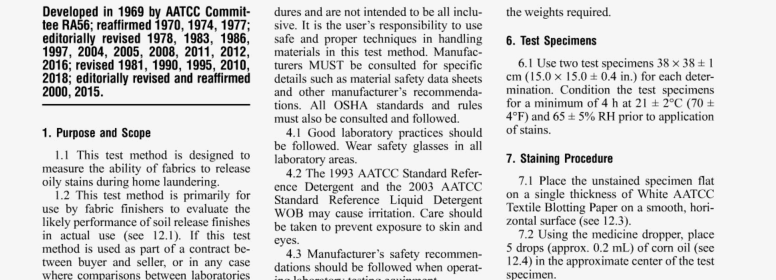Oily Stain Release Method

AATCC 130-2018 pdf free.Soil Release: Oily Stain Release Method.
Remove specimens from dryer immediately on completion of the cycle and lay flat to prevent formation of wrinkles or creases which can affect the stain iv- lease rating. Rate residual stains within 4 h after drying.
9. Evaluation
9.1 Mount the stain release replica on the mounting board, with the center of the standard 114 ± 3 cm (45 ± I in.) from the floor (sec 12.10).
9.2 Place the test specimen flat with face up in the center of the non-glare black topped table with one edge of the table touching the mounting board. The fabric shall be rotated to be viewed from the direction which produces the lowest rating.
9.3 Viewing distance shall be 76 ± 3 cm (30 ± I in.) from the back mounting board, with the eye at 157 ± 15cm (62 ± 6 in.) from the floor. The rater should stand directly in front of the specimen. Vaxying the viewing angle either horizontally or vertically can affect grades obtained on some fabrics.
9.4 Each rater shall independently corn- pare the residual stain on the test specimen with the stains on the stain release replica and rate each test specimen to the nearest 0.5 grade according to Table 11.
10. Report
10.1 Calculate the average of 4 grades for each fabric. (2 judgments on each of 2 specimens). to nearest 0.1. This is the unit of measure for this test method.
10.2 Report whether the Stain Release Replica or the 3M Stain Release Rating Scale was used.
10.3 Report the washing procedure used by appropriate Roman numeral from Tablc I.
10.4 If stain(s) other than the corn oil are used, idcniit each stain and report thc stain release grade obtained for each stain separately (see 1214).
10.5 Report water hardness of the washing procedure in terms of parts per million (ppm).
10,6 Report the type ballast material used.
10.7 Report the detergent type and amount used and the phosphorus content of the detergent as indicated on the container (see 12.8 and 12.13).
10.8 Report manufacturer and model number of the washer and dryer.
11. Precision and Bias
11.1 Summar An interlaboratorv test was carried out in the summer of 1987 to establish the precision of this test method. One operator at each of 5 labora.tones tested 2 specimens of each of 5 fabrics each day for 3 days using I washer and I dryer. A detergent. widely available in the U.S. which contained 9,8% phosphate. was used (see 12.8). The reference vegetable oil used was Maiola brand corn oil (sec 12.4) because it was widely available and consistent in color and quality. Two raters independently evalu.atcd the specimens using the Stain Relcasc Replica and the 3M Stain Release Rating Scale. The unit of measure was the average of the 2 gradcs for the 2 specimens tested each day. The fabrics were limited to polyester and polyester cotton materials, most having soil release finishes.
12.1 The 1995 revision of this method ic(lects the change in lrmulation of the reference detergent and provides an addiüonal choice of ballast in order to more nearly evaluate the pertormance of soil release hnishes under conditions of actual use. Corn oil has been retained as the reierencc oily stain. Preliminary comparative studies with the new reference detergent and new ballast Type 3 were conducted by the AATCC Laborakwy. No statistical difIercncc at the 95% probability level was observed for the new ballast Type 3. However, these early results indicate a statistical ditThrcnce between the new 1993 AATCC Standard Reference Detergent and the previous AATCC Standard Reference Detergent 124, the new detergent tending to be less cliicient toward oily stain release removal.
12.2 For potential equipment inturmation pertaining to this test method, please visit the online AA TCC Buyer : (iuId at www. aatcc.org/bg. AATCC provides the possibility of listing equipment and materials sold by its Corporate members, but AATCC does not qualify, or in any way approve, endorse or certify that any of the listed equipment or materials meets the requirements in its test methods.AATCC 130 pdf download.Oily Stain Release Method